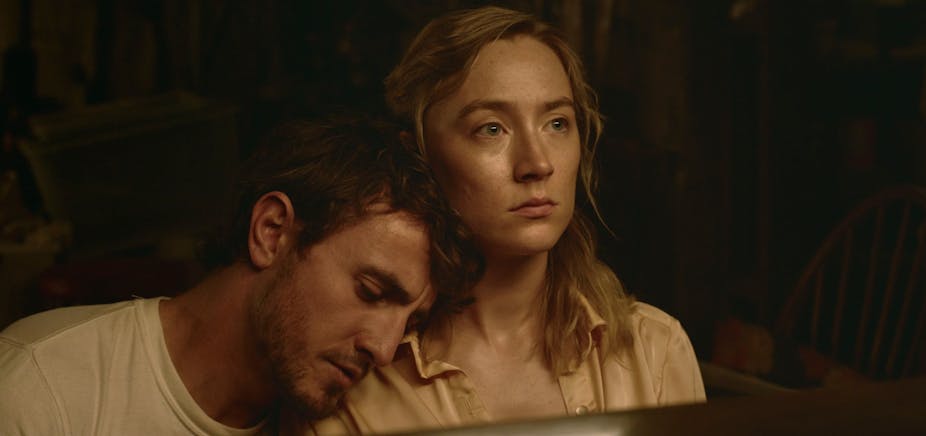Science fiction is never really about the future. The best sci-fi makes use of an imagined future world to provide a critical distance from our current time; to ask questions about what we are doing rather than where we are going.
Director Garth Davis’ Foe, adapted from the novel by Iain Reid, is sci-fi for a future that has already happened. Filmed in Australia, where the existing landscape does a good job of standing in for the aftermath of the climate apocalypse, Foe is a forceful meditation on relationships, technological determinism and the power of advanced capitalism to, literally, construct identities.
Henrietta (Saoirse Ronan) and Junior (Paul Mescal) live in isolation in the American midwest. The year is 2065 and a powerful tech corporation called OuterSense is spearheading migration to The Installation, an orbiting artificial world designed as refuge from a dying planet Earth.
Junior, it transpires, has won a lottery that he wasn’t aware of entering and has been chosen for a two-year sojourn on The Installation. All the couple needs to do is make temporary room in their home for Terrance (Aaron Pierre), an OuterSense scientist. Terrance will study Junior and his interactions with Hen in order to craft a “biological replacement” – a lab-grown substitute husband complete with Junior’s personality and physiology. What, we are primed to ask, could possibly go wrong?
Not quite human
The techno-doppelgänger is a standard trope of sci-fi and one of its most successful in terms of posing questions about the human condition. There are nods here to Ridley Scott’s Blade Runner and Bryan Forbes’ 1975 adaptation of Ira Levin’s novel The Stepford Wives in which a group of men replace their feminist wives with compliant cyborgs. Both, I think, were sci-fi cinema landmarks because they had scripts that offered acting talent the chance to play not-quite-humans while questioning what “human” means in the first place, but without costumes or CGI.
Foe asks similar questions. Keeping the techno-wizardry to a minimum and presenting a recognisable world in a strange context allows audiences to gain a new perspective on their own realities. This is known as defamiliarisation, which is a feature of the sci-fi genre that enables strangeness to emerge through subtle clues in the script, rather than futuristic or other-worldly sets.
In Foe, flying cars (again reminiscent of Blade Runner) make a brief and sudden appearance towards the end to reinforce the sense that the future – if there is one – is elsewhere. And like both Blade Runner and The Stepford Wives, the costume design for Foe gestures towards the past and a time when, at least in the US, the future looked both hi-tech and utopian.

Where Foe stands out is that it allows nuanced performances from Ronan and Mescal that strike just the right balance between the easy conformity of a happy relationship and the unsettling friction that emerges as Junior begins to suspect that he is being manipulated. My personal standout, however, would go to Aaron Pierre as Terrance who plays his part with just a hint of the kind of indulgent benevolence you might reserve for a child.
Who’s the monster?
Most of the action takes place in Hen and Junior’s house, which is both a sanctuary and a prison. It provides shelter from the extreme weather but is also where Hen and Junior are trapped as OuterSense asserts control over them. It is also a laboratory where, it gradually emerges, Terrance is leading an experiment to harvest parts of Junior’s personality in order to create an AI copy just a bit more pliable to Henrietta’s concerns than the original.
In this sense, Foe is, like much sci-fi, a sort-of retelling of Mary Shelley’s Frankenstein story, but with an evil corporation in the role of transgressing scientist. OuterSense is clearly representative of the kinds of transhumanist startups supported by tech billionaires like Elon Musk, Jeff Bezos and Peter Thiel.
Transhumanists believe that, with planet Earth doomed, our only recourse is to employ bioengineering to manufacture the next stage of evolution. Transhumanist companies are developing techniques that will enable us to live forever in a paradise beyond the stars, but only if we have sufficient medical insurance. In Foe, OuterSense offers insurance against a dying world with Hen and Junior the lab rats who will prove the concept and attract the necessary financial investment.
While OuterSense fights to “save” humanity, throughout the film we see rhinoceros beetles. These serve as a subtle cinematic device that remind us there are other lifeforms better placed than us to inherit the future.
Victor Frankenstein’s monster threatens that he will be with him on his wedding night. What Foe asks us to consider is whether we’ve already made room for the monster and allowed it to take up residence in our homes.

Looking for something good? Cut through the noise with a carefully curated selection of the latest releases, live events and exhibitions, straight to your inbox every fortnight, on Fridays. Sign up here.

